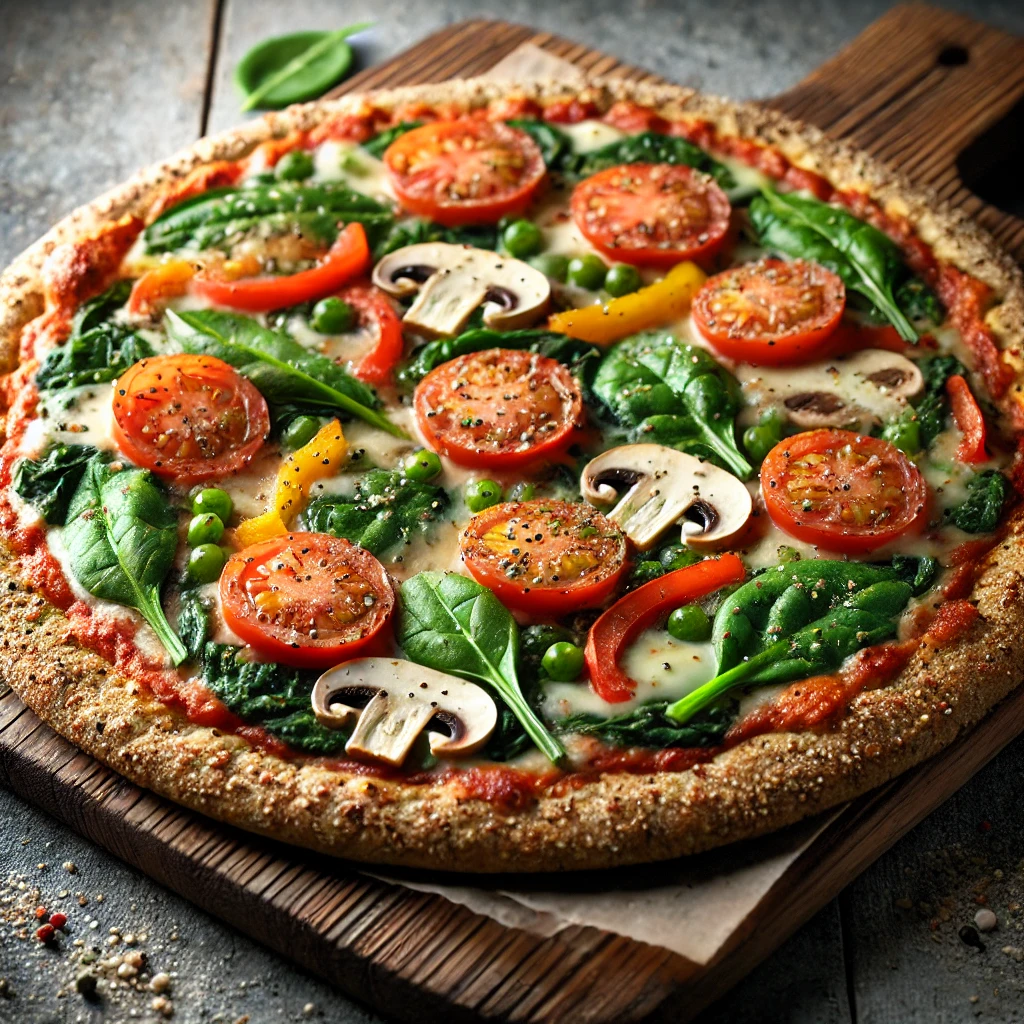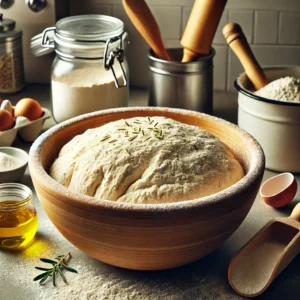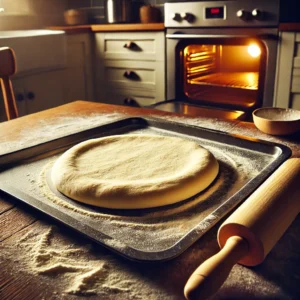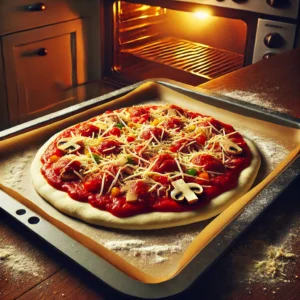Craving a delicious pizza but avoiding gluten? Look no further than this easy and tasty gluten-free pizza recipe, perfect for any occasion. Whether you’re gluten-intolerant, have celiac disease, or just want to try a healthier pizza alternative, this recipe has got you covered. You can enjoy all the rich flavours and textures of traditional pizza with a crisp, chewy crust—without the gluten.
In this comprehensive guide, we’ll explore everything you need to know to make a perfect gluten-free pizza, from the ingredients and equipment required to step-by-step instructions, tips for achieving the best crust, and ideas for delicious toppings. By the end of this article, you’ll be ready to make your own mouthwatering gluten-free pizza at home!
Why Choose Gluten-Free Pizza?
There are several reasons why you might opt for a gluten-free pizza beyond gluten intolerance or celiac disease:
1. Health Benefits
Many people find that reducing or eliminating gluten from their diet improves digestion, reduces inflammation, and boosts overall health. Gluten-free flours are often made from nutrient-dense grains like rice, quinoa, and sorghum, which provide a variety of vitamins and minerals.
2. Variety of Flavors
Gluten-free flours bring unique flavours to the crust that you don’t get from regular wheat flour. You can experiment with different flour blends to find the taste and texture that best suits you.
3. Easy to Customize
Gluten-free pizza dough can be easily adjusted with various herbs, seasonings, and toppings to create a completely personalized pizza experience.
Ingredients You’ll Need for Gluten-Free Pizza
Here’s a breakdown of the ingredients needed to make a delicious gluten-free pizza:
Basic Ingredients:
- 2 1/4 cups gluten-free flour (for baking)
- 1 tablespoon instant yeast
- 1 teaspoon sugar (helps activate the yeast)
- 1 teaspoon salt
- 3/4 cup warm water (about 110°F or 43°C, to activate the yeast)
- 2 tablespoons olive oil (for richness and moisture)
- 1 1/2 cups shredded mozzarella cheese (or any cheese of your choice)
Optional Ingredients:
- 1 tablespoon apple cider vinegar (for added tanginess and dough elasticity)
- Herbs and spices like garlic powder, dried oregano, or basil enhance flavour
- Pizza sauce (store-bought or homemade)
- Toppings like mushrooms, bell peppers, olives, pepperoni, fresh basil, or arugula
Ingredient Substitutions:
- If you don’t have apple cider vinegar, you can substitute it with lemon juice or white vinegar.
- You can use your favourite cheese instead of mozzarella, such as cheddar, Parmesan, or a dairy-free alternative if you’re vegan.
Equipment You’ll Need
To make gluten-free pizza, you’ll need a few essential kitchen tools:
- Oven: Preheating is crucial for a good pizza crust.
- Pizza stone (optional): This helps create a crispier crust.
- Rolling pin: For stretching the dough.
- Pizza tray or baking sheet: For baking the pizza.
- Large bowl: For mixing the dough.
- Small bowl: For activating the yeast.
Step-by-Step Guide to Making Gluten-Free Pizza
Making a gluten-free pizza at home is simpler than you might think. Follow these detailed steps to get a perfect pizza every time.
1. Prepare the Yeast Mixture
To start, you need to activate the yeast:
- In a small bowl, combine 3/4 cup warm water (around 110°F or 43°C), 1 teaspoon sugar, and 1 tablespoon instant yeast.
- Stir gently and let the mixture sit for 5-10 minutes until it becomes frothy and bubbly. This indicates that the yeast is active.
2. Mix the Dry Ingredients
While the yeast is activating:
- In a large mixing bowl, combine 2 1/4 cups gluten-free flour and 1 teaspoon salt. Stir thoroughly to evenly distribute the salt.
3. Form the Dough
Once the yeast is activated:
- Add the yeast mixture, 2 tablespoons of olive oil, and 1 tablespoon of apple cider vinegar (if using) to the flour mixture.
- Combine the ingredients until a soft dough forms. You can use a wooden spoon, dough whisk, or your hands to knead the dough for about 2-3 minutes. The dough should be smooth and slightly sticky but easy to handle.
4. Let the Dough Rise
For the best texture:
- Cover the dough with a clean kitchen towel or plastic wrap and place it in a warm area to rise for 30-45 minutes. This resting period helps the dough develop more flavor and texture.
Tip: If your kitchen is cool, you can let the dough rise in an oven with the light on or near a warm stove.
5. Preheat the Oven
Preheat your oven to 220°C (430°F). If you’re using a pizza stone, be sure to place it in the oven to preheat as well. Preheating ensures a crisp crust.
6. Roll Out the Dough
Once the dough has risen:
- Dust a clean work surface with a little gluten-free flour.
- Transfer the dough to the surface and use a rolling pin to roll it out to your desired thickness. Keep the dough round or shape it to fit a pizza tray.
7. Pre-Bake the Dough (Optional)
For a crispier crust:
- Transfer the rolled-out dough to a lightly oiled pizza tray or preheated pizza stone.
- Pre-bake the dough for 5 minutes. This step helps the crust firm up, so it doesn’t get soggy when you add the toppings.
8. Add Toppings
Now comes the fun part:
- Spread your favourite pizza sauce over the pre-baked crust.
- Sprinkle 1 1/2 cups of shredded mozzarella cheese evenly over the sauce.
- Add any other toppings you like, such as mushrooms, bell peppers, olives, pepperoni, or fresh herbs.
9. Bake the Pizza
Place the pizza in the preheated oven and bake for 15-20 minutes, or until the edges are golden brown and the cheese is bubbling and melted.
10. Serve and Enjoy
Take the pizza out of the oven and let it rest for a few minutes to cool. Slice it into pieces and serve hot. Enjoy your delicious, gluten-free creation!
Tips for Making the Perfect Gluten-Free Pizza
While making gluten-free pizza is straightforward, these tips can help ensure you get the best results:
1. Choose the Right Flour Blend
The key to a good gluten-free pizza dough is a quality flour blend. Look for gluten-free flour that includes a mix of rice flour, tapioca starch, potato starch, and a binding agent like xanthan gum or guar gum. These ingredients help replicate the texture of traditional flour.
2. Don’t Skip the Pre-Bake
Pre-baking the crust for a few minutes before adding the toppings can make a big difference. It helps set the dough so it doesn’t get soggy and ensures a crispier base.
3. Use Olive Oil for a Better Texture
Adding a small amount of olive oil to the dough adds richness, moisture, and a slight crispiness to the crust. Brush a little olive oil over the edges of the dough for a golden-brown finish.
4. Add Herbs to the Dough
For extra flavour, add dried herbs like oregano, basil, or garlic powder directly to the dough. This enhances the overall taste of the crust and gives it an Italian flair.
5. Adjust Baking Time Based on Thickness
If you prefer a thicker crust, you may need to extend the baking time by a few minutes to ensure the centre is fully cooked. For a thin, crispy crust, keep a close eye on the baking time to prevent overcooking.
Delicious Gluten-Free Pizza Topping Ideas
One of the best things about pizza is the endless variety of toppings you can add. Here are some ideas to inspire your next gluten-free pizza creation:
1. Classic Margherita
- Tomato sauce
- Fresh mozzarella cheese
- Fresh basil leaves
- Drizzle of olive oil
2. Veggie Delight
- Tomato sauce
- Mozzarella cheese
- Sliced bell peppers
- Red onions
- Mushrooms
- Olives
- Spinach
3. BBQ Chicken Pizza
- BBQ sauce instead of tomato sauce
- Cooked, shredded chicken
- Red onions
- Mozzarella and cheddar cheese
- Fresh cilantro
4. Mediterranean Pizza
- Olive oil base
- Feta cheese
- Kalamata olives
- Red onions
- Cherry tomatoes
- Artichoke hearts
- Fresh arugula after baking
5. Pepperoni Supreme
- Tomato sauce
- Mozzarella cheese
- Sliced pepperoni
- Sausage crumbles
- Green bell peppers
- Mushrooms
- Red onions
Feel free to mix and match
these toppings to create your perfect gluten-free pizza. Don’t be afraid to get creative!
Nutrition Information (Per Serving)
Here’s a typical nutritional breakdown for a serving of gluten-free pizza:
- Calories: 420 kcal
- Carbohydrates: 51g
- Protein: 17g
- Fat: 19g
- Saturated Fat: 7g
- Polyunsaturated Fat: 1g
- Monounsaturated Fat: 8g
- Cholesterol: 33mg
- Sodium: 845mg
- Potassium: 42mg
- Fiber: 7g
- Sugar: 4g
- Vitamin A: 284 IU
- Vitamin C: 0.003 mg
- Calcium: 258 mg
- Iron: 3 mg
Frequently Asked Questions (FAQs)
1. Can I make gluten-free pizza dough ahead of time?
Yes! Prepare the dough in advance and store it in the refrigerator for up to 24 hours. Let it come to room temperature before rolling it out.
2. Can I freeze gluten-free pizza dough?
Absolutely. Form the dough into a ball, wrap it tightly in plastic wrap, and store it in a freezer-safe bag. You can freeze it for up to 3 months. Thaw it in the refrigerator overnight before using.
3. How do I make the crust crispier?
To get a crispier crust, pre-bake the dough for a few minutes before adding the toppings. You can also use a pizza stone or bake the pizza on the bottom rack of the oven for the last few minutes.
4. What gluten-free flour is best for pizza dough?
Look for a gluten-free flour blend that contains rice flour, tapioca starch, and xanthan gum. These ingredients help mimic the texture of traditional pizza dough.
5. Can I make this recipe dairy-free?
Yes! Use a dairy-free cheese substitute, such as vegan mozzarella, and ensure all other ingredients, like the sauce, are dairy-free.
Conclusion
Gluten-free pizza is not only a fantastic option for those with gluten sensitivities, but it’s also a delicious and versatile meal that anyone can enjoy. With a few simple ingredients and the right techniques, you can create a gluten-free pizza that’s every bit as satisfying as traditional pizza. Whether you’re making a classic Margherita, a loaded veggie delight, or a bold BBQ chicken pizza, this recipe will surely impress.
So gather your ingredients, get creative with your toppings, and enjoy a slice of homemade, gluten-free pizza today!
For more detailed gluten-free pizza, check out the link.

Gluten-Free Pizza.
Equipment
- 1 Oven:
- 1 Pizza Stone optional if you're using one
- 1 Rolling Pin for stretching the dough.
Ingredients
- 2 1/4 cups Gluten-free flour For baking
- 1 tablespoon instant yeast
- 1 teaspoon sugar
- 1 teaspoon salt
- 3/4 cup warm water
- 2 tablespoons olive oil
- 1 1/2 cup shredded mozzarella chees
Instructions
- In a small bowl, combine warm water, sugar, and yeast.Let it sit for 5–10 minutes until it becomes frothy.
- In a large bowl, mix together the gluten-free flour and salt until well combined.until well combined. until well combined.until well combined. Add the yeast mixture, olive oil, and apple cider vinegar (if using). Mix well until a smooth dough forms.

- Cover the dough and allow it to rise in a warm place for 30–45 minutes.
- Preheat your oven to 220°C (430°F).Roll out the dough on a floured surface, then transfer it to a lightly oiled pizza tray.

- Spread the sauce, add cheese and toppings, and bake for 15-20 minutes until the edges are golden

Notes
-
Tips for better dough preparation:
- “For a crispier crust, you can pre-bake the pizza dough for 5 minutes before adding the toppings.”
-
Topping suggestions:
- “Feel free to adjust the toppings to suit your tastes and preferences. To customise the dish, add mushrooms, bell peppers, olives, or pepperoni.”
-
Ingredient substitutions:
- “If you don’t have apple cider vinegar, substitute with lemon juice or white vinegar.”
-
Storage and reheating:
- “Store leftover pizza in the fridge for up to 3 days to keep it fresh. Reheat in the oven for 5-7 minutes at 180°C (350°F) for a crisp crust.”




